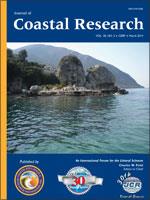Godoy, M.D.P. and de Lacerda, L.D., 2014. River-island morphological response to basin land-use change within the Jaguaribe River estuary, NE Brazil.
The Jaguaribe River drains the largest watershed of the Ceará state in northeastern Brazil, which, with a catchment of approximately 75,000 km2, comprises more than 50% of the total state area. Land use and global climate changes are altering the river morphology, making navigation in the estuary difficult. Mapping of fluvial islands using images from the Landsat 5 between 1988 and 2010 showed that the existing islands in the estuary suffered great changes during this period. Overall, there was an increase of 24.15 ha in the area of the islands, which are presently being colonized by mangrove vegetation. The period of largest growth occurred between 1992 and 2003, when there was an increase of 13 ha at a rate of 2.7 ha y−1. An estimate of the sediment loading from various land uses in the watershed showed that the main activity contributing to sediments to the estuary is agriculture (282,322 t y−1), with the main contributions stemming from plantations of beans, cassava, and corn; the second-most important source of sediments is urban runoff (115,076 t y−1), followed by shrimp farms (13,475 t y−1) and livestock (1374 t y−1). The increased rate of sedimentation in the estuary caused by land-use drivers is aggravated by the decrease in river flow caused by damming and the decrease in rainfall over the basin caused by global climate change.





